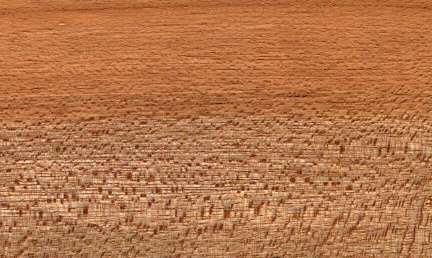
Yemeri (Vochysia ferruginea)
Family: Vochysiaceae
Common names: Barbachele, Barbara chele, Cambara, Cedrorana, Chimbuya, Corosillo, Grignon fou, Iteballi, Killu sisa, Kouali, Kwari, Mayo, Moutende, Palo de chancho, Plumero, Quaruba, Red Kwarie, San Juan de pozo, Tintin, Wanakwari, Wiswiskwari
Distributed in: Columbia, Ecuador, Guyana, Nicaragua, Panama, Peru, Suriname, Venezuela (Central America, Latin America)
Distribution overview: The genus Vochysia is composed of several shrubs and trees that are distributed throughout tropical America, from southern Mexico to Peru, but are most plentiful in the Guianas and Brazil. Trees are reported to form nearly pure stands on old farmlands, and attain their best development on coastal plains and along waterways.
Common uses: Balusters, Bedroom suites, Bent Parts, Boxes and crates, Building materials, Cabinetmaking, Casks, Ceiling, Chairs, Chests, Concealed parts (Furniture), Decorative veneer, Desks, Dining-room furniture, Dowell pins, Dowells, Drawer sides, Figured veneer, Fine furniture, Floor lamps, Furniture , Furniture components, Furniture squares or stock, General carpentry, Hatracks, Interior construction, Kitchen cabinets, Living-room suites, Millwork, Office furniture, Packing cases, Paddles, Radio - stereo - TV cabinets, Rustic furniture, Sporting Goods, Stairrails, Stairworks, Stools, Stringers, Tables , Utility furniture, Veneer
Product sources: The ITTO reports that the species is an important source of timber and rates as a fairly important export.Timber produced by species in the genus are used for the same purposes as those by the genus Qualea, and the two genera are often referred to by the same vernacular name in some localities.
Environment profile: Status has not been officially assessed
Tree size: Trunk diameter is 100-150 cm
Colors: the heart isPurple, Redand the sapwoodWhite to yellow, Yellow.The grain isStraight, the textureModerately coarseand the lusterMedium
Natural durability: Susceptible to insect attack, Very durable
Odor: No specific smell or taste
Kiln Schedules: T2 - D4 (4/4); T2 - D3 (8/4) US
Kiln Drying Rate: Slow
Drying Defects: Severe twisting/warping, Splitting
Ease of Drying: Slowly
Comments: Low resistance to decay. Difficult to work after drying. Can be used as drawer bottoms, panels, or plywood
Blunting Effect: Moderate
Boring: Satisfactory properties
Carving: Fairly Easy to Very Easy
Cutting Resistance: Moderate to saw
Gluing: Good properties
Mortising: Poor to Very Poor
Moulding: Good moulding properties
Movement in Service: Good moulding properties
Nailing: Pre-Boring Recommended, Very Good to Excellent
Planing: Woolly
Resistance to Impregnation: Resistant sapwood
Response to hand tools: Responds well
Routing recessing: Very sharp cutting edges are required to produce a smooth surface
Sanding: Very Good to Excellent Results
Veneering qualities: Suitable for peeling
Screwing: Pre-boring recommended, Very Good to Excellent Results; Turning: Very Good to Excellent Results
Painting: Very Good to Excellent; Polishing: Very Good to Excellent; Staining: Stains well
Water-Based stains should be avoided since they tend to raise the grain
; Varnishing: Very Good to Excellent;
- Numerical data Metric
- Numerical data English
- Strength properties
- References
 |
 |
 |
 |
| Item |
Green |
Dry |
Metric |
| Specific Gravity |
0,46 |
0,52 |
|
| Density |
|
544 |
kg/m3 |
| Bending Strength |
459 |
751 |
kg/cm2 |
| Crushing Strength |
216 |
418 |
kg/cm2 |
| Hardness |
|
268 |
kg |
| Impact Strength |
|
|
cm |
| Shearing Strength |
|
106 |
kg/cm2 |
| Stiffness |
86 |
109 |
1000 kg/cm2 |
| Tangential Shrinkage |
10 |
|
% |
| Radial Shrinkage |
4 |
|
% |
| Weight |
769 |
480 |
kg/m3 |
| Maximum Load |
0,7 |
0,91 |
cm-kg/cm3 |
| Toughness |
|
|
cm-kg |
| Static Bending |
|
|
kg/cm2 |
|
 |  |  |  | | Item | Green | Dry | English | | Bending Strength | 6540 | 10695 | psi | | Density | | 34 | lbs/ft3 | | Hardness | | 593 | lbs | | Maximum Crushing Strength | 3082 | 5959 | psi | | Shearing Strength | | 1509 | psi | | Stiffness | 1235 | 1555 | 1000 psi | | Work to Maximum Load | 10 | 13 | inch-lbs/in3 | | Specific Gravity | 0.46 | 0.52 | | | Weight | 48 | 30 | lbs/ft3 | | Radial Shrinkage | 4 | | % | | Tangential Shrinkage | 10 | | % | | Volumetric Shrinkage | 15 | | % | |
Compression strength (parallel to grain) = medium
Bending strength (MOR) = high
High density, medium weight, surfaces may dent or scratch easily
Boone, R.S., C.J. Kozlik, P.J. Bois, E.M. Wengert. 1988. Dry Kiln Schedules for Commercial Woods - Temperate and Tropical. USDA., Forest Service, Preliminary Copy, Forest Products Laboratory, Madison, Wisconsin.CAOBA International, San Francisco, California. 1993. Personal Communication.Chichignoud, M., G. Deon, P. Detienne, B. Parant and P. Vantomme.1990.Tropical Timber Atlas of Latin America.International Tropical Timber Organization (ITTO, Centre Technique Forestier Tropical, Division of CIRAD, 45 bis Avenue de la Belle Gabrielle, Nogent-sur-Marne, CEDEX, France.Chudnoff, M.,1984,Tropical Timbers of the World,U.S.A. Department of Agriculture, Forest Service, Forest Products,Laboratory, Madison.HMSO.1981.Handbook of Hardwoods, 2nd Edition.Revised by R. H. Farmer.Department of the Environment, Building Research Establishment, Princes Risborough Laboratory, Princes Risborough, Aylesbury, Buckinghamshire.ITTO. 1991. Tropical Timber Atlas of Latin America.Association Internationale Technique des Bois Tropicaux, Centre Technique Forestier Tropical Division of CIRAD, 45 bis, Avenue de la Belle Gabrielle, Nogent-sur-marne, CEDEX, FranceLavers, G.M. 1966. The Strength Properties of Timbers. Forest Products Research Bulletin, No. 50. Ministry of Technology, Her Majesty's Stationery Office, London.Record, S.J. and R.W. Hess. 1943. Timbers of the New World. Published on the Charles Lathrop Pack Foundation, Yale University Press, New Haven CT.WCMC. 1992. Conservation Status Listing - Trees and Timbers of the World, World Conservation Monitoring Centre, Plants Programme, 219 Huntingdon Road, Cambridge, CB3 ODL, United Kingdom.
|








